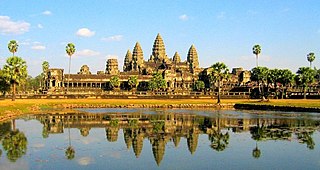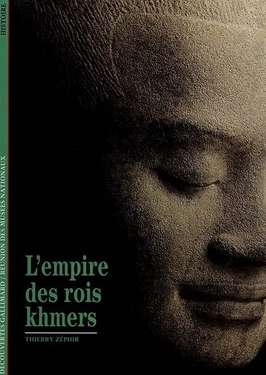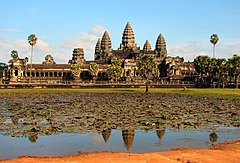
Khmer architecture, also known as Angkorian architecture, is the architecture produced by the Khmers during the Angkor period of the Khmer Empire from approximately the later half of the 8th century CE to the first half of the 15th century CE.

Angkor, also known as Yasodharapura, was the capital city of the Khmer Empire. The city and empire flourished from approximately the 9th to the 15th centuries. The city houses the Angkor Wat, one of Cambodia's most popular tourist attractions.

Angkor Thom, alternatively Nokor Thom, located in present-day Cambodia, was the last and most enduring capital city of the Khmer Empire. It was established in the late twelfth century by King Jayavarman VII. It covers an area of 9 km², within which are located several monuments from earlier eras as well as those established by Jayavarman and his successors. At the centre of the city is Jayavarman's state temple, the Bayon, with the other major sites clustered around the Victory Square immediately to the north. The site is one of the major tourist attractions of Southeast Asia.
Articles related to Cambodia and Cambodian culture include:

Jayavarman VII, posthumous name of Mahaparamasaugata,, was king of the Khmer Empire. He was the son of King Dharanindravarman II and Queen Sri Jayarajacudamani. He was the first king devoted to Buddhism, as only one prior Khmer king had been a Buddhist. He then built the Bayon as a monument to Buddhism. Jayavarman VII is generally considered the most powerful of the Khmer monarchs by historians. His government built many projects including hospitals, highways, rest houses, and temples. With Buddhism as his motivation, King Jayavarman VII is credited with introducing a welfare state that served the physical and spiritual needs of the Khmer people.

Preah Vihear is a province (khaet) of Cambodia. It borders the provinces of Oddar Meanchey and Siem Reap to the west, Kampong Thom to the south and Stung Treng to the east. Its northern boundary forms part of Cambodia's international border with Thailand and Laos. Its capital is Preah Vihear.

Siem Reap, officially Siemreap, is a province (khaet) of Cambodia. It borders the provinces of Oddar Meanchey to the north, Preah Vihear and Kampong Thom to the east, Battambang to the south, and Banteay Meanchey to the west. Its capital and largest city is Siem Reap.

The Dângrêk Mountains, also the Dângrêk Range, is a mountain range forming a natural border between Cambodia and Thailand.

Suryavarman I was king of the Khmer Empire from 1006 to 1050. Suryavarman usurped King Udayadityavarman I, defeating his armies in approximately 1002. After a protracted war with Udayadityavarman's would-be successor, Jayavirahvarman, Suryavarman I claimed the throne in 1010. Suryavarman was a Mahayana Buddhist who was also tolerant of the growing Theravada Buddhist presence in the Khmer kingdom.

Preah Vihear Temple is an ancient Hindu temple built by the Khmer Empire, located on top of a 525-metre (1,722 ft) cliff in the Dângrêk Mountains, in the Preah Vihear province of Cambodia.

The Royal Palace of Cambodia is a complex of buildings which serves as the official royal residence of the King of Cambodia. Its full name in Khmer is the Preah Barom Reacheaveang Chaktomuk Serey Mongkol. The Cambodian monarchs have occupied it since it was built in the 1860s, with a period of absence when the country came into turmoil during and after the reign of the Khmer Rouge.

The Silver Pagoda is located on the south side of the Royal Palace in Chey Chumneas, Phnom Penh. The official name is Wat Ubaosoth Ratanaram, also known as Wat Preah Keo Morakot which is commonly shortened to Wat Preah Keo in Khmer.
Theravada Buddhism is the state religion of Cambodia, which has been present since at least the 5th century.

A wat is a type of Buddhist and Hindu temple in Cambodia, Laos, East Shan State, Yunnan, the Southern Province of Sri Lanka, and Thailand.

The archeological complex of Preah Khan Kampong Svay, also known as Prasat Bakan, or Bakan Svay Rolay, is located 100 km east of Angkor, in the Preah Vihear province of Cambodia. It stands as the largest single religious complex ever built during the Angkorian Era, as its exterior enclosure is over 22 km square, even if the isolated location makes it one of the less-visited Angkorian sites.

Sbai or phaa biang is a shawl-like garment worn by women in Cambodia, Laos, and Thailand to cover the breasts, while in Sumatra, Borneo and the Malay Peninsula, the same term is used to describe a cloth hanging from the shoulders. The sbai was derived from the Indian sari, the end of which is worn over one shoulder.

Bilateral relations between Cambodia and Thailand date to the 13th century during the Angkor Era. The Thai Ayutthaya Kingdom gradually displaced the declining Khmer Empire from the 14th century, French protectorateship separated Cambodia from modern Thailand at the turn of the 19th–20th centuries, and diplomatic relations between the modern states were established on 19 December 1950.

Cambodian irredentism is a nationalist movement in Cambodia that refers to the land that used to be part of the Khmer Empire. The movement is aimed against Thai, Vietnamese, and Laotian control over the territories. Both official and unofficial Cambodian claims on territories viewed as having been under some form of Cambodian sovereignty are rhetorically tied back to an accused expansionism.

The Cambodia–Thailand border is the international border between Cambodia and Thailand. The border is 817 km (508 mi) in length and runs from the tripoint with Laos in the north-east to the Gulf of Thailand in the south.

Khmer: The Lost Empire of Cambodia is a 1997 illustrated monograph on the culture and history of Khmer Kingdoms. Written by Thierry Zéphir, a professor of the École du Louvre, and published by Éditions Gallimard as the 310th volume in their "Découvertes" collection, in collaboration with the Réunion des Musées Nationaux.


















